TOYOTA AURIS 2013 Owners Manual (in English)
Manufacturer: TOYOTA, Model Year: 2013, Model line: AURIS, Model: TOYOTA AURIS 2013Pages: 768, PDF Size: 21.22 MB
Page 701 of 768
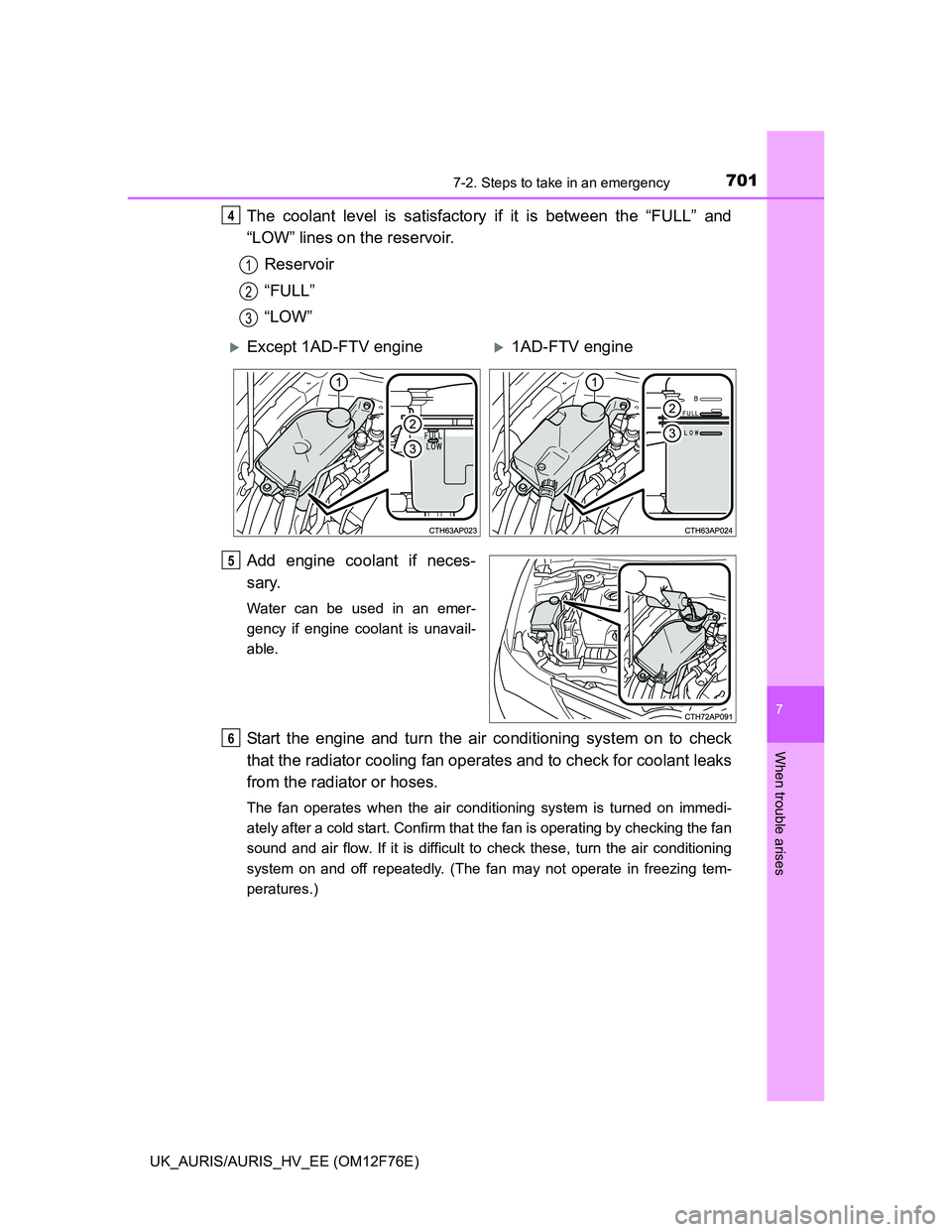
7017-2. Steps to take in an emergency
UK_AURIS/AURIS_HV_EE (OM12F76E)
7
When trouble arises
The coolant level is satisfactory if it is between the “FULL” and
“LOW” lines on the reservoir.
Reservoir
“FULL”
“LOW”
Add engine coolant if neces-
sary.
Water can be used in an emer-
gency if engine coolant is unavail-
able.
Start the engine and turn the air conditioning system on to check
that the radiator cooling fan operates and to check for coolant leaks
from the radiator or hoses.
The fan operates when the air conditioning system is turned on immedi-
ately after a cold start. Confirm that the fan is operating by checking the fan
sound and air flow. If it is difficult to check these, turn the air conditioning
system on and off repeatedly. (The fan may not operate in freezing tem-
peratures.)
4
1
2
3
Except 1AD-FTV engine1AD-FTV engine
5
6
Page 702 of 768
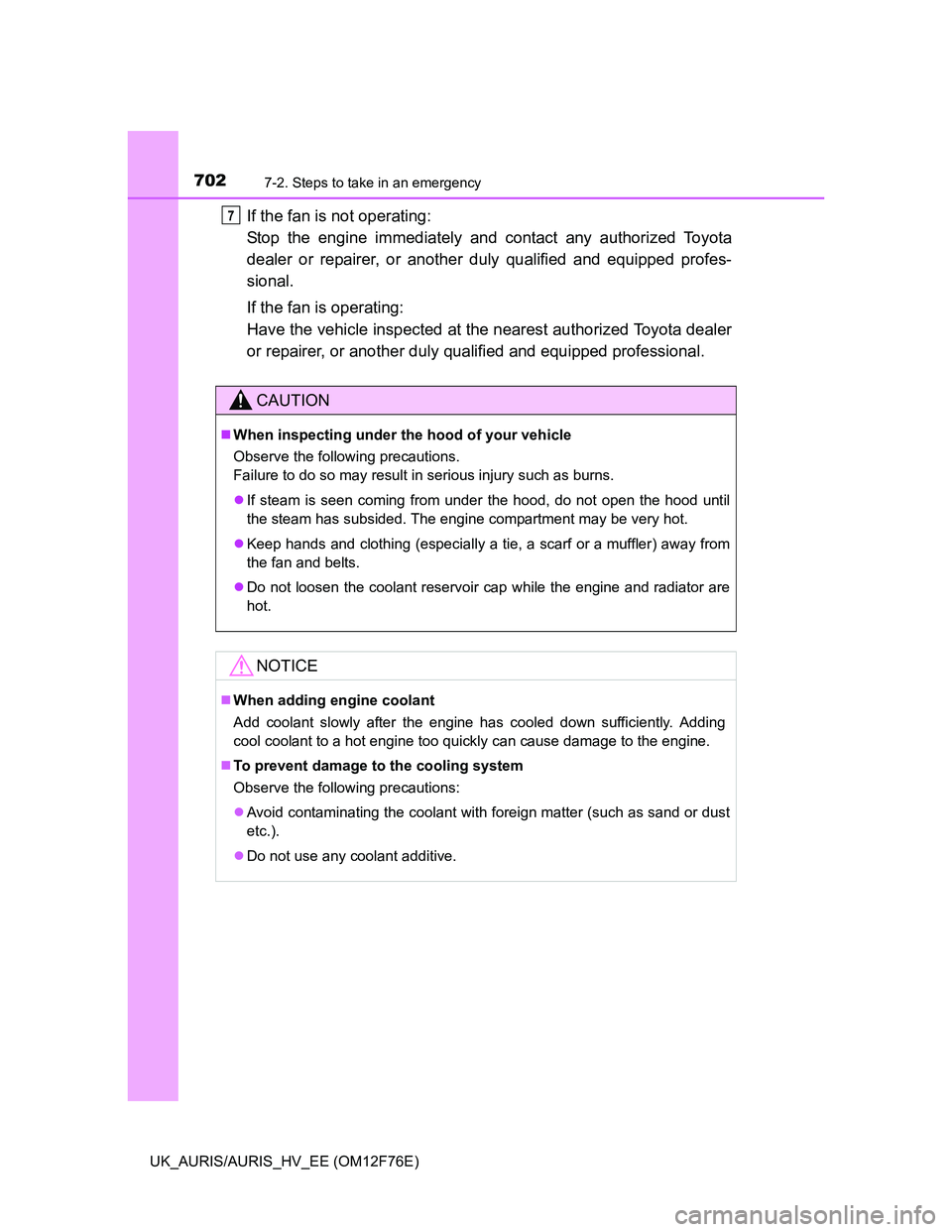
7027-2. Steps to take in an emergency
UK_AURIS/AURIS_HV_EE (OM12F76E)
If the fan is not operating:
Stop the engine immediately and contact any authorized Toyota
dealer or repairer, or another duly qualified and equipped profes-
sional.
If the fan is operating:
Have the vehicle inspected at the nearest authorized Toyota dealer
or repairer, or another duly qualified and equipped professional.
CAUTION
When inspecting under the hood of your vehicle
Observe the following precautions.
Failure to do so may result in serious injury such as burns.
If steam is seen coming from under the hood, do not open the hood until
the steam has subsided. The engine compartment may be very hot.
Keep hands and clothing (especially a tie, a scarf or a muffler) away from
the fan and belts.
Do not loosen the coolant reservoir cap while the engine and radiator are
hot.
NOTICE
When adding engine coolant
Add coolant slowly after the engine has cooled down sufficiently. Adding
cool coolant to a hot engine too quickly can cause damage to the engine.
To prevent damage to the cooling system
Observe the following precautions:
Avoid contaminating the coolant with foreign matter (such as sand or dust
etc.).
Do not use any coolant additive.
7
Page 703 of 768
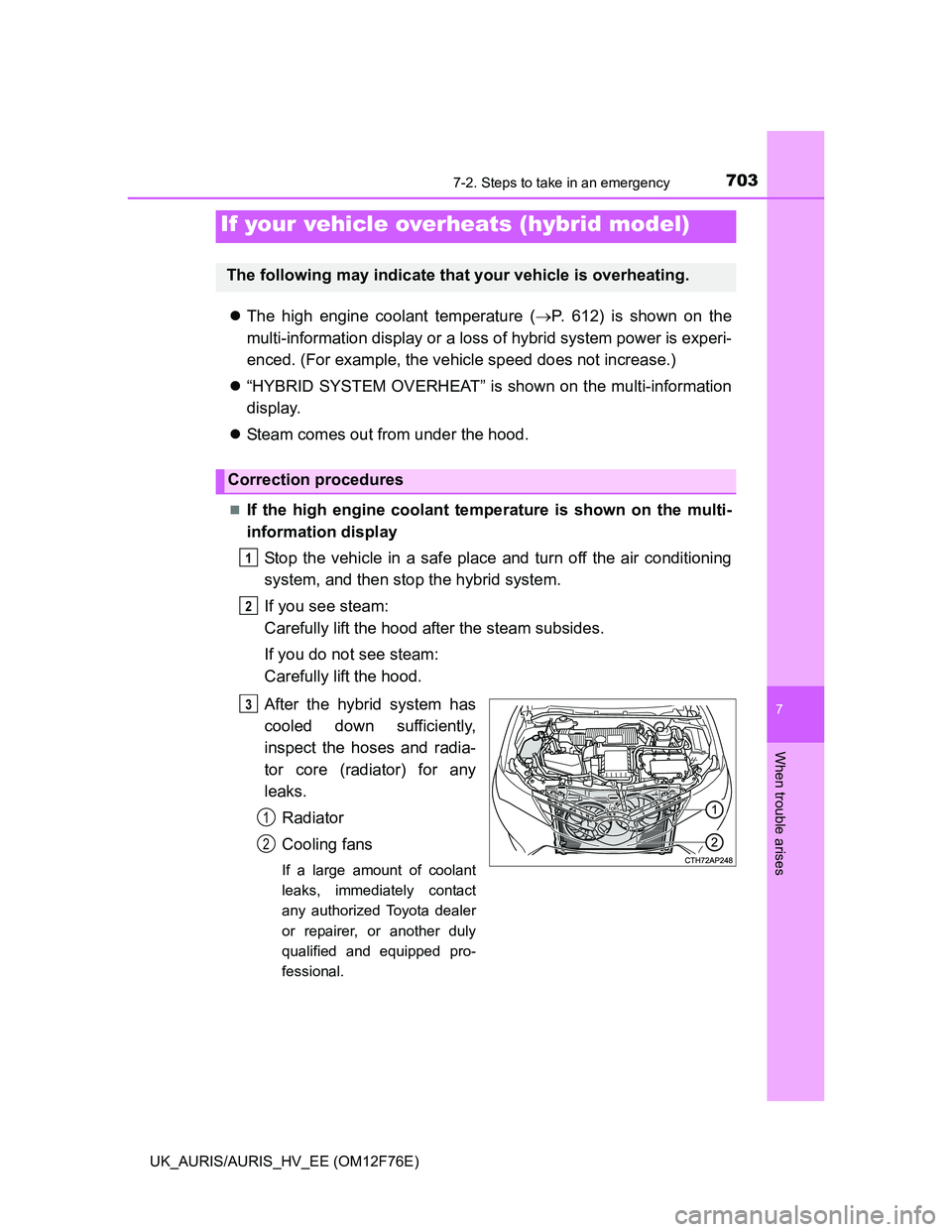
7037-2. Steps to take in an emergency
UK_AURIS/AURIS_HV_EE (OM12F76E)
7
When trouble arises
The high engine coolant temperature (P. 612) is shown on the
multi-information display or a loss of hybrid system power is experi-
enced. (For example, the vehicle speed does not increase.)
“HYBRID SYSTEM OVERHEAT” is shown on the multi-information
display.
Steam comes out from under the hood.
If the high engine coolant temperature is shown on the multi-
information display
Stop the vehicle in a safe place and turn off the air conditioning
system, and then stop the hybrid system.
If you see steam:
Carefully lift the hood after the steam subsides.
If you do not see steam:
Carefully lift the hood.
After the hybrid system has
cooled down sufficiently,
inspect the hoses and radia-
tor core (radiator) for any
leaks.
Radiator
Cooling fans
If a large amount of coolant
leaks, immediately contact
any authorized Toyota dealer
or repairer, or another duly
qualified and equipped pro-
fessional.
If your vehicle overheats (hybrid model)
The following may indicate that your vehicle is overheating.
Correction procedures
1
2
3
1
2
Page 704 of 768
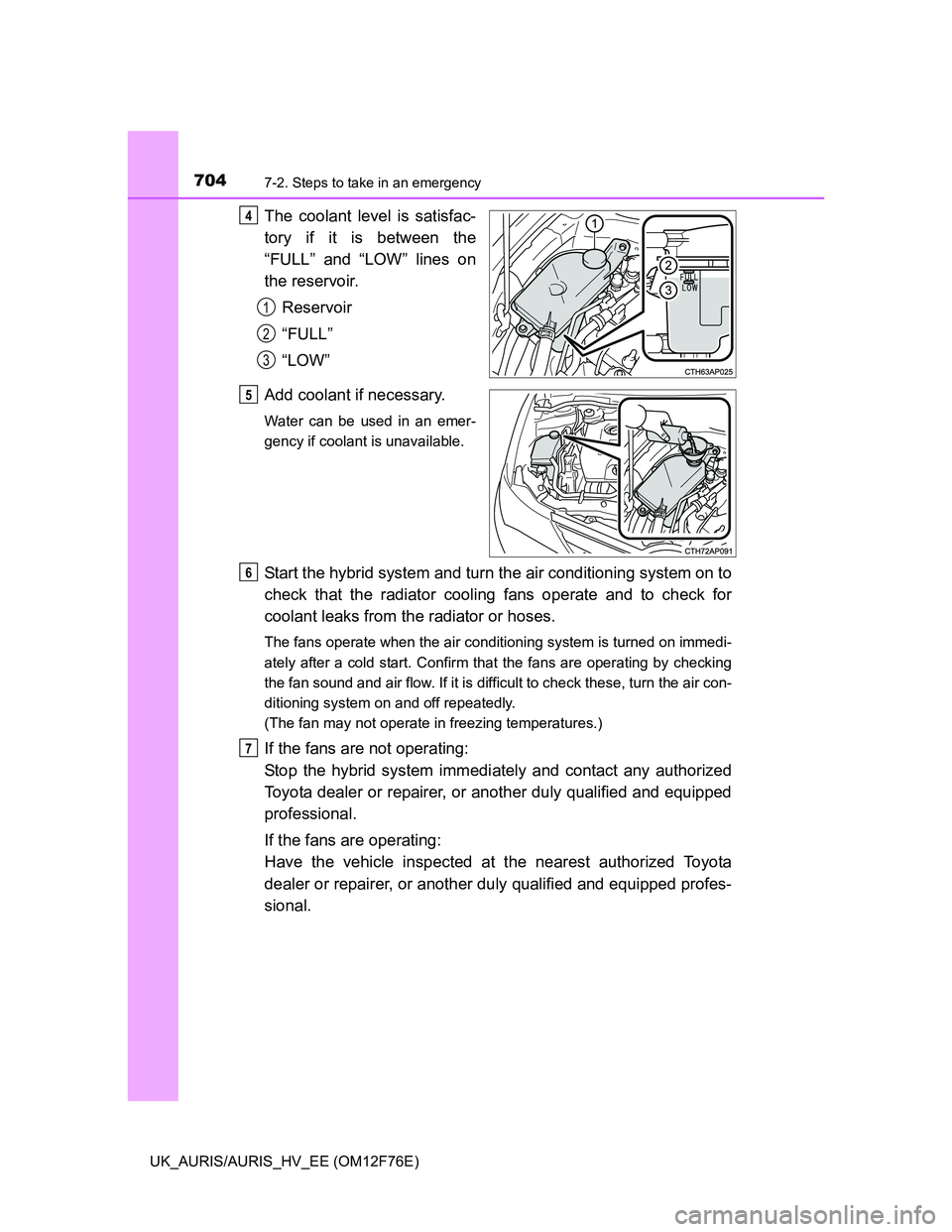
7047-2. Steps to take in an emergency
UK_AURIS/AURIS_HV_EE (OM12F76E)
The coolant level is satisfac-
tory if it is between the
“FULL” and “LOW” lines on
the reservoir.
Reservoir
“FULL”
“LOW”
Add coolant if necessary.
Water can be used in an emer-
gency if coolant is unavailable.
Start the hybrid system and turn the air conditioning system on to
check that the radiator cooling fans operate and to check for
coolant leaks from the radiator or hoses.
The fans operate when the air conditioning system is turned on immedi-
ately after a cold start. Confirm that the fans are operating by checking
the fan sound and air flow. If it is difficult to check these, turn the air con-
ditioning system on and off repeatedly.
(The fan may not operate in freezing temperatures.)
If the fans are not operating:
Stop the hybrid system immediately and contact any authorized
Toyota dealer or repairer, or another duly qualified and equipped
professional.
If the fans are operating:
Have the vehicle inspected at the nearest authorized Toyota
dealer or repairer, or another duly qualified and equipped profes-
sional.
4
1
2
3
5
6
7
Page 705 of 768
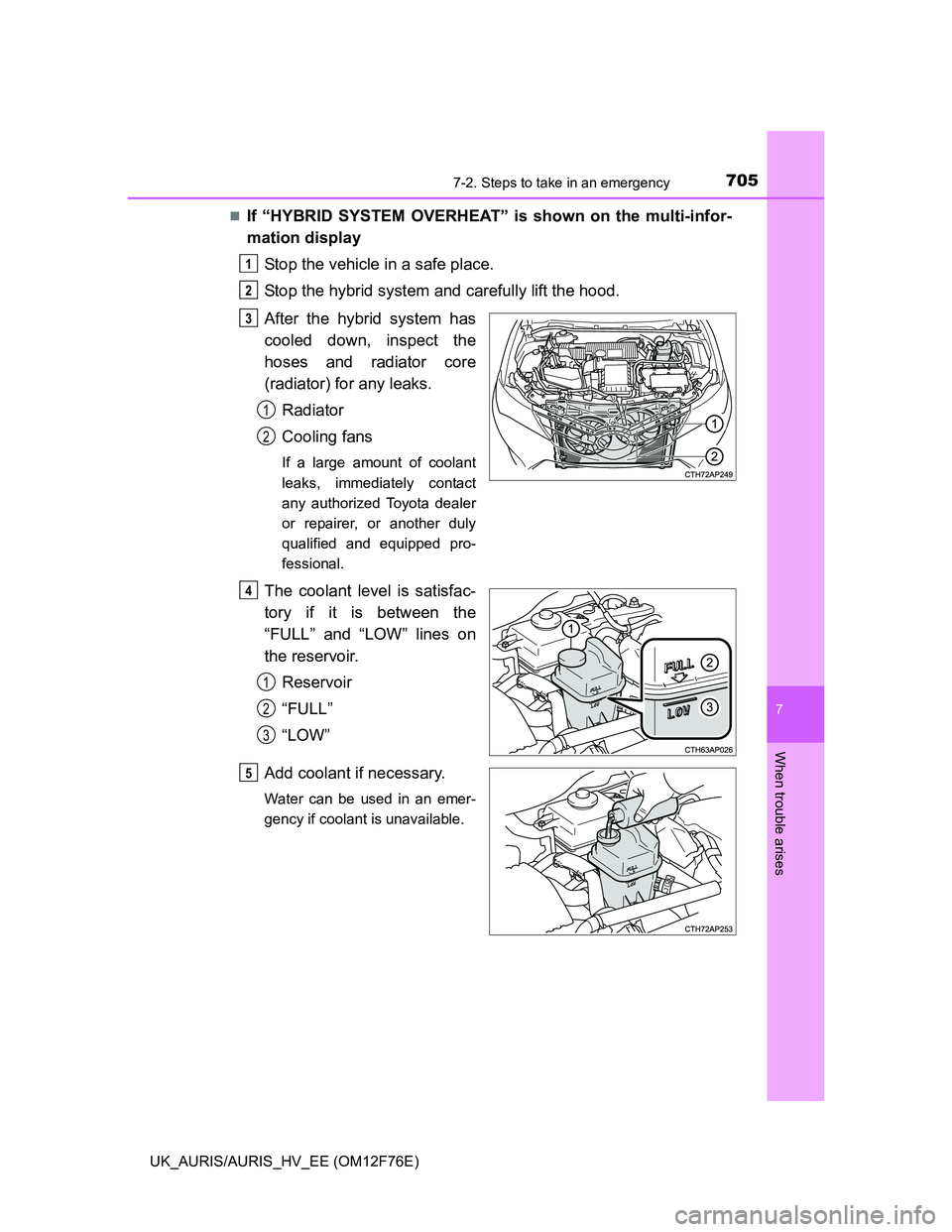
7057-2. Steps to take in an emergency
UK_AURIS/AURIS_HV_EE (OM12F76E)
7
When trouble arises
If “HYBRID SYSTEM OVERHEAT” is shown on the multi-infor-
mation display
Stop the vehicle in a safe place.
Stop the hybrid system and carefully lift the hood.
After the hybrid system has
cooled down, inspect the
hoses and radiator core
(radiator) for any leaks.
Radiator
Cooling fans
If a large amount of coolant
leaks, immediately contact
any authorized Toyota dealer
or repairer, or another duly
qualified and equipped pro-
fessional.
The coolant level is satisfac-
tory if it is between the
“FULL” and “LOW” lines on
the reservoir.
Reservoir
“FULL”
“LOW”
Add coolant if necessary.
Water can be used in an emer-
gency if coolant is unavailable.
1
2
3
1
2
4
1
2
3
5
Page 706 of 768
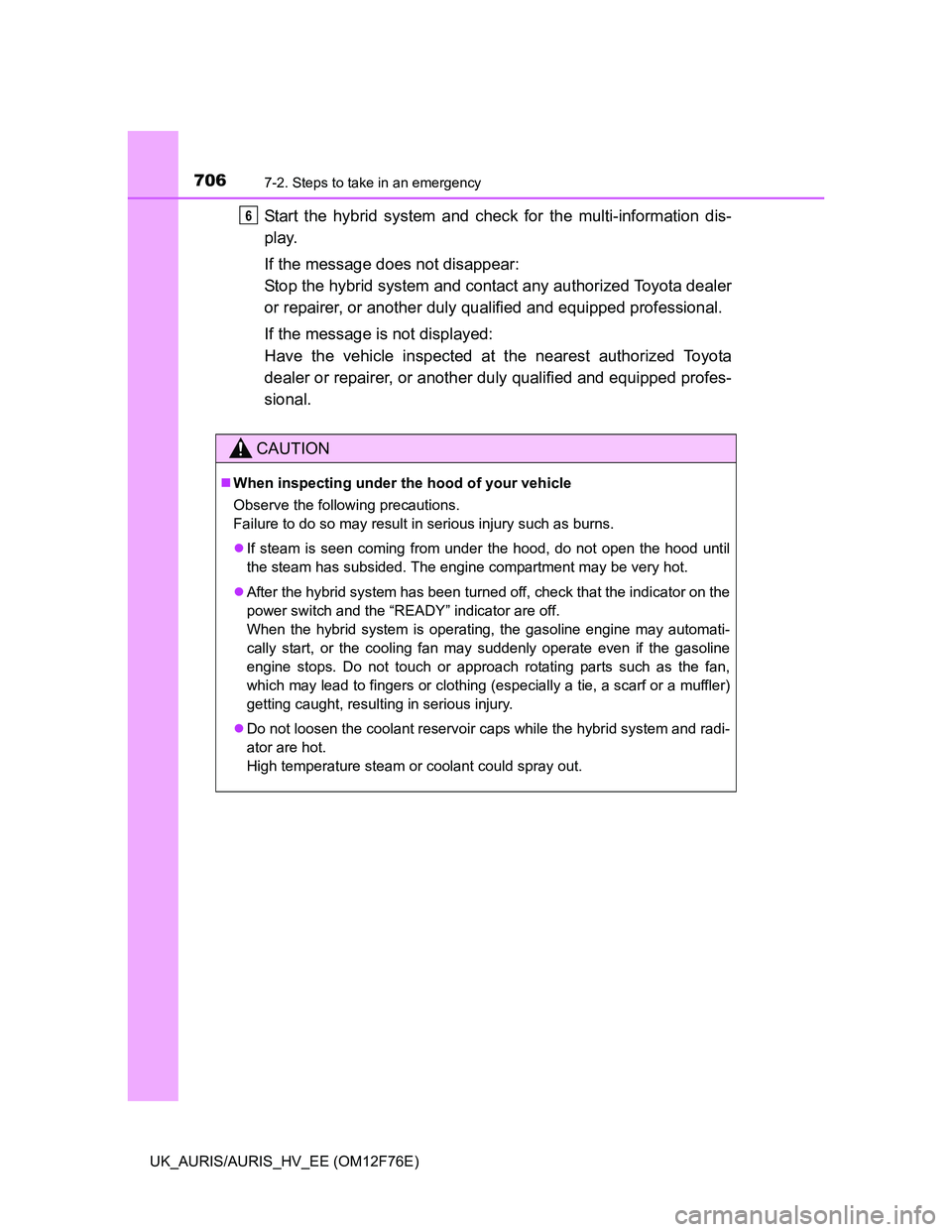
7067-2. Steps to take in an emergency
UK_AURIS/AURIS_HV_EE (OM12F76E)
Start the hybrid system and check for the multi-information dis-
play.
If the message does not disappear:
Stop the hybrid system and contact any authorized Toyota dealer
or repairer, or another duly qualified and equipped professional.
If the message is not displayed:
Have the vehicle inspected at the nearest authorized Toyota
dealer or repairer, or another duly qualified and equipped profes-
sional.
CAUTION
When inspecting under the hood of your vehicle
Observe the following precautions.
Failure to do so may result in serious injury such as burns.
If steam is seen coming from under the hood, do not open the hood until
the steam has subsided. The engine compartment may be very hot.
After the hybrid system has been turned off, check that the indicator on the
power switch and the “READY” indicator are off.
When the hybrid system is operating, the gasoline engine may automati-
cally start, or the cooling fan may suddenly operate even if the gasoline
engine stops. Do not touch or approach rotating parts such as the fan,
which may lead to fingers or clothing (especially a tie, a scarf or a muffler)
getting caught, resulting in serious injury.
Do not loosen the coolant reservoir caps while the hybrid system and radi-
ator are hot.
High temperature steam or coolant could spray out.
6
Page 707 of 768
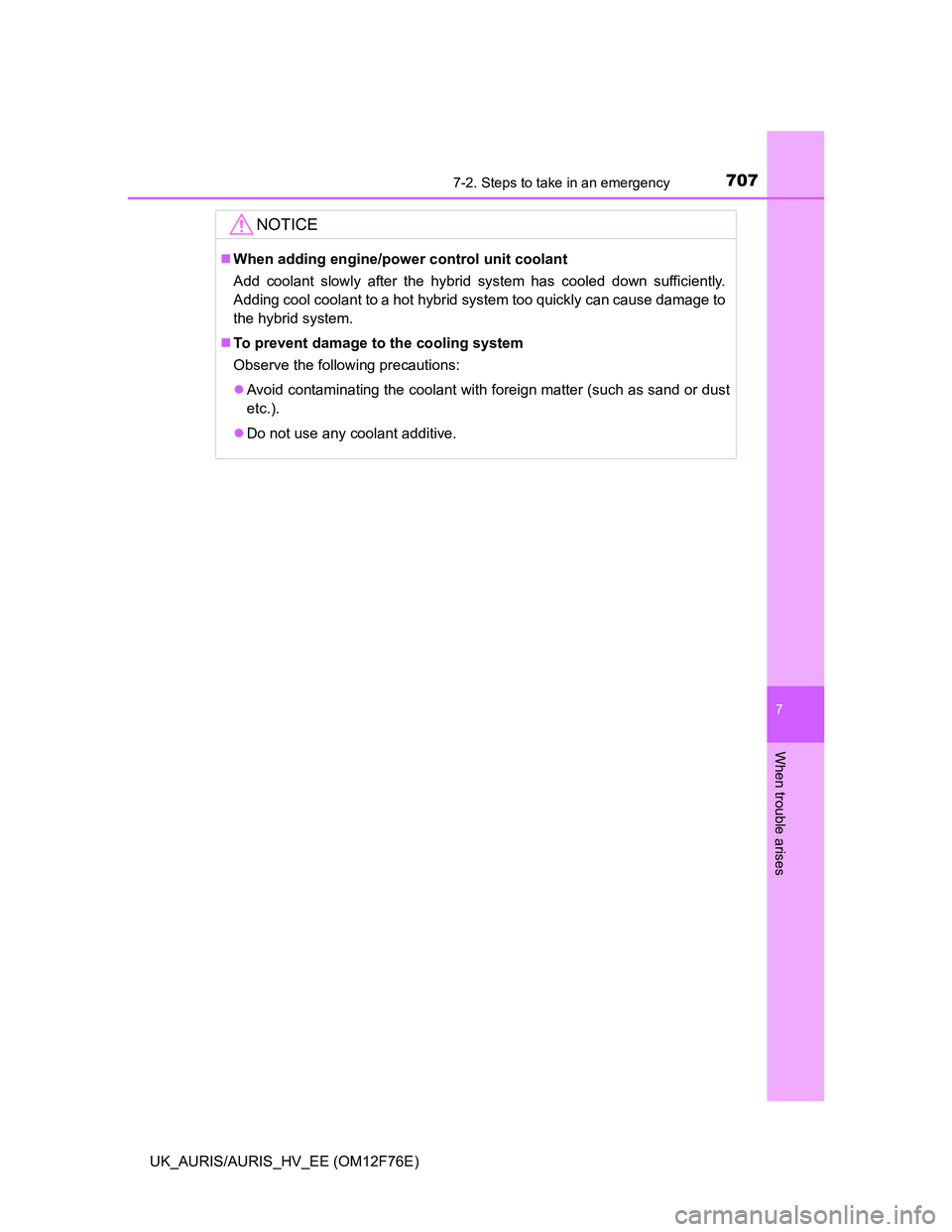
7077-2. Steps to take in an emergency
UK_AURIS/AURIS_HV_EE (OM12F76E)
7
When trouble arises
NOTICE
When adding engine/power control unit coolant
Add coolant slowly after the hybrid system has cooled down sufficiently.
Adding cool coolant to a hot hybrid system too quickly can cause damage to
the hybrid system.
To prevent damage to the cooling system
Observe the following precautions:
Avoid contaminating the coolant with foreign matter (such as sand or dust
etc.).
Do not use any coolant additive.
Page 708 of 768
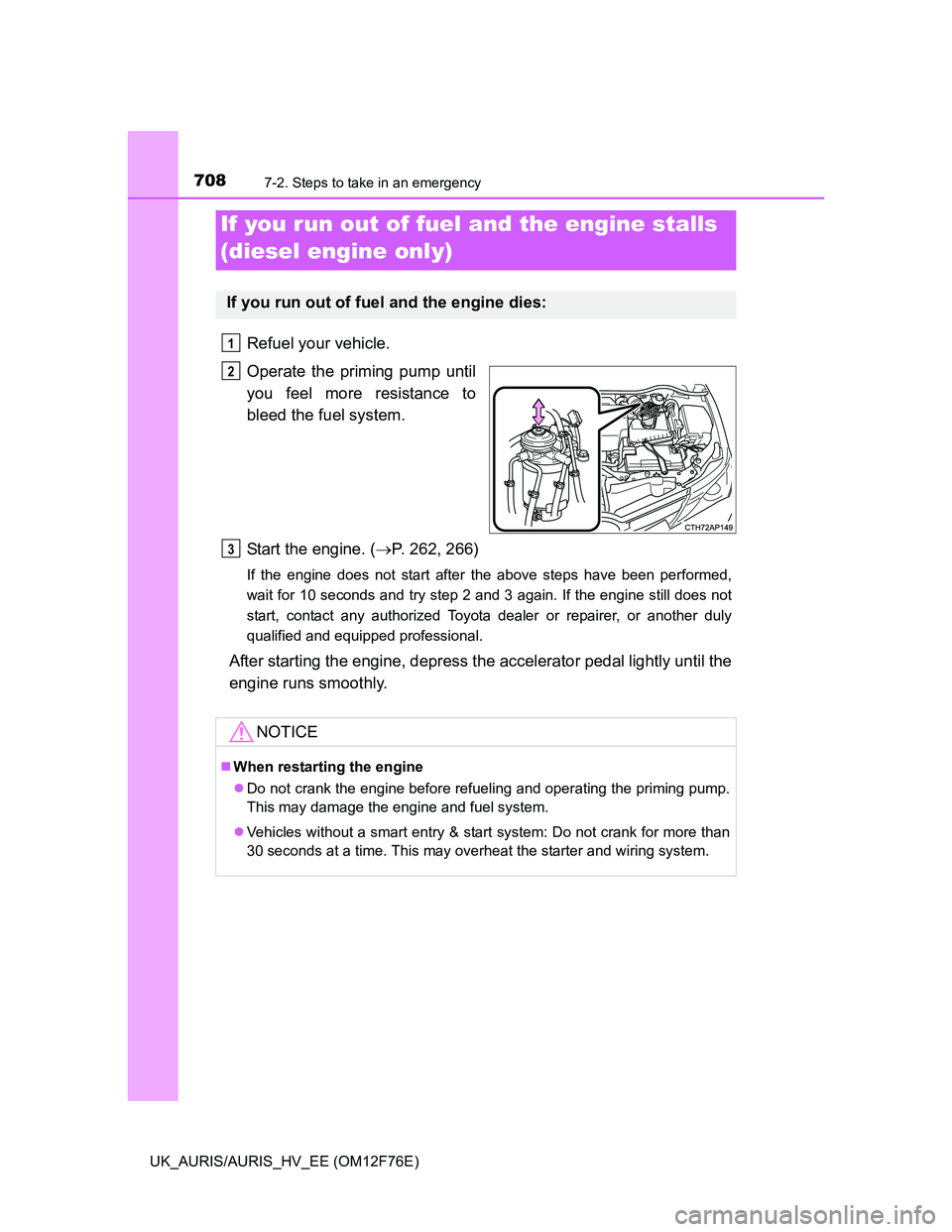
7087-2. Steps to take in an emergency
UK_AURIS/AURIS_HV_EE (OM12F76E)
Refuel your vehicle.
Operate the priming pump until
you feel more resistance to
bleed the fuel system.
Start the engine. (P. 262, 266)
If the engine does not start after the above steps have been performed,
wait for 10 seconds and try step 2 and 3 again. If the engine still does not
start, contact any authorized Toyota dealer or repairer, or another duly
qualified and equipped professional.
After starting the engine, depress the accelerator pedal lightly until the
engine runs smoothly.
If you run out of fuel and the engine stalls
(diesel engine only)
If you run out of fuel and the engine dies:
1
2
NOTICE
When restarting the engine
Do not crank the engine before refueling and operating the priming pump.
This may damage the engine and fuel system.
Vehicles without a smart entry & start system: Do not crank for more than
30 seconds at a time. This may overheat the starter and wiring system.
3
Page 709 of 768

7097-2. Steps to take in an emergency
UK_AURIS/AURIS_HV_EE (OM12F76E)
7
When trouble arises
Except hybrid model
Stop the engine. Shift the shift lever to P (Multidrive) or N (man-
ual transmission and multi-mode manual transmission), and set
the parking brake.
Remove the mud, snow or sand from around the front wheels.
Place wood, stones or some other material under the front
wheels to help provide traction.
Restart the engine.
Shift the shift lever to D or R (Multidrive) or 1 or R (manual trans-
mission and multi-mode manual transmission) and release the
parking brake. Then, while exercising caution, depress the accel-
erator pedal.
Hybrid model
Set the parking brake and stop the hybrid system.
Remove the mud, snow, or sand from around the front wheels.
Place wood, stones or some other material under the front
wheels to help provide traction.
Restart the hybrid system.
Shift the shift position to D or R and release the parking brake.
Then, while exercising caution, depress the accelerator pedal.
If the vehicle becomes stuck
Carry out the following procedures if the tires spin or the vehicle
becomes stuck in mud, dirt or snow:
1
2
3
4
5
1
2
3
4
5
Page 710 of 768
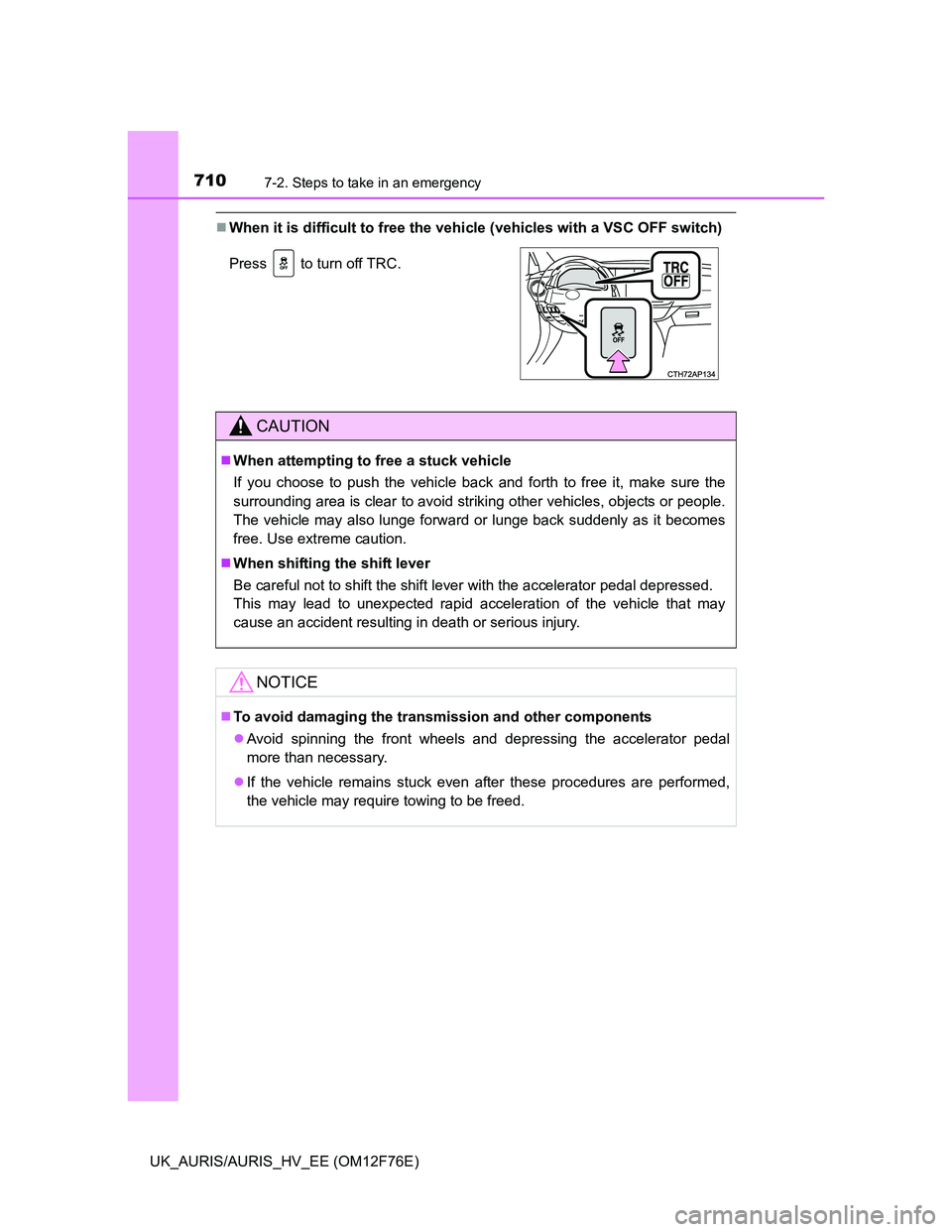
7107-2. Steps to take in an emergency
UK_AURIS/AURIS_HV_EE (OM12F76E)
When it is difficult to free the vehicle (vehicles with a VSC OFF switch)
Press to turn off TRC.
CAUTION
When attempting to free a stuck vehicle
If you choose to push the vehicle back and forth to free it, make sure the
surrounding area is clear to avoid striking other vehicles, objects or people.
The vehicle may also lunge forward or lunge back suddenly as it becomes
free. Use extreme caution.
When shifting the shift lever
Be careful not to shift the shift lever with the accelerator pedal depressed.
This may lead to unexpected rapid acceleration of the vehicle that may
cause an accident resulting in death or serious injury.
NOTICE
To avoid damaging the transmission and other components
Avoid spinning the front wheels and depressing the accelerator pedal
more than necessary.
If the vehicle remains stuck even after these procedures are performed,
the vehicle may require towing to be freed.